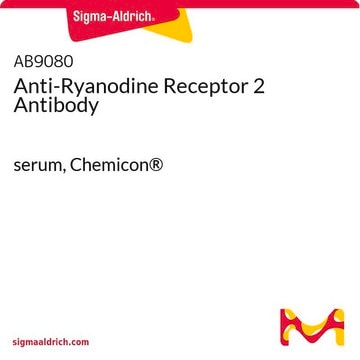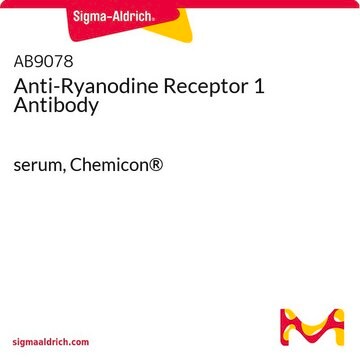MAB3086
Anti-Ryanodine Receptor Antibody, clone RYR.1
clone RYR.1, Chemicon®, from mouse
About This Item
Prodotti consigliati
Origine biologica
mouse
Livello qualitativo
Forma dell’anticorpo
purified immunoglobulin
Tipo di anticorpo
primary antibodies
Clone
RYR.1, monoclonal
Reattività contro le specie
rat, human, mouse, pig, bovine, canine
Produttore/marchio commerciale
Chemicon®
tecniche
ELISA: suitable
flow cytometry: suitable
immunocytochemistry: suitable
immunohistochemistry: suitable
immunoprecipitation (IP): suitable
radioimmunoassay: suitable
western blot: suitable
Isotipo
IgG2b
N° accesso NCBI
N° accesso UniProt
Condizioni di spedizione
dry ice
modifica post-traduzionali bersaglio
unmodified
Informazioni sul gene
human ... RYR1(6261)
Categorie correlate
Specificità
Immunogeno
Applicazioni
Immunocytochemistry: 1:100 by indirect immunofluorescence. Visualization by confocal microscopy is required, as detection by standard fluorescent microscopy will not be adequate to detect the RyR. Additionally, fluorescent, not enzymatic, detection is required. Due to the intensity of confocal lasers, use of an anti-fading agent, such as DABCO, is strongly recommended.
Immunoprecipitation: 1:100
Flow cytometry: 1:500
ELISA: 1:1000
Immunohistochemistry: 1:100
RIA: 1:5000
Optimal working dilutions must be determined by the end user.
Neuroscience
Ion Channels & Transporters
Signaling Neuroscience
Stato fisico
Stoccaggio e stabilità
Altre note
Note legali
Esclusione di responsabilità
Not finding the right product?
Try our Motore di ricerca dei prodotti.
Codice della classe di stoccaggio
12 - Non Combustible Liquids
Classe di pericolosità dell'acqua (WGK)
WGK 2
Punto d’infiammabilità (°F)
Not applicable
Punto d’infiammabilità (°C)
Not applicable
Certificati d'analisi (COA)
Cerca il Certificati d'analisi (COA) digitando il numero di lotto/batch corrispondente. I numeri di lotto o di batch sono stampati sull'etichetta dei prodotti dopo la parola ‘Lotto’ o ‘Batch’.
Possiedi già questo prodotto?
I documenti relativi ai prodotti acquistati recentemente sono disponibili nell’Archivio dei documenti.
Il team dei nostri ricercatori vanta grande esperienza in tutte le aree della ricerca quali Life Science, scienza dei materiali, sintesi chimica, cromatografia, discipline analitiche, ecc..
Contatta l'Assistenza Tecnica.






